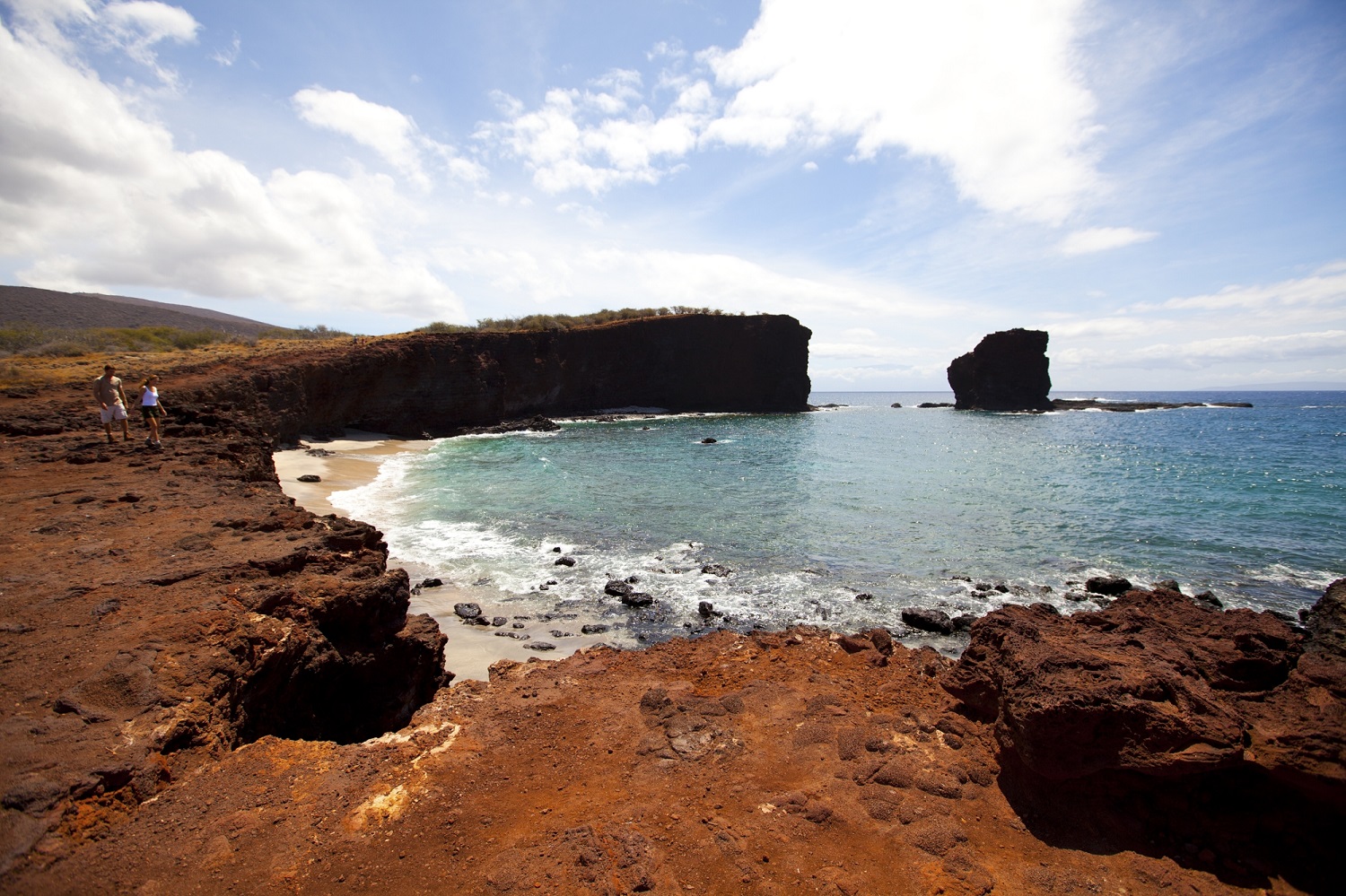Located just nine miles from Maui, Lanai seems like a world-away from the hustle-and-bustle of modern city-life. The smallest inhabited island in Hawaii has no stoplights, and only thirty miles of its roads are paved. Only three hotels reside on what was once called The Pineapple Island.
If you want to escape and relax, you won’t find a better place than Lanai.
History of Lanai
Lanai was uninhabited until the 1500’s and was always a place of mystery even to Native Hawaiians. Legends tell the story of a challenge between kahuna (priests) that scorched the earth of Keahikawelo (Garden of the Gods), explaining some of the otherworldly terrain of the island.
Lanai was a sovereign land until King Kamehameha I united the Hawaiian islands into one royal monarchy in 1810. You can see the ruins of Kamehameha’s favorite summer fishing retreat in South Lanai. Called Kaunolu, this sacred spot and fishing village has been registered as a National Historic Landmark. Home to Halulu heiau (religious temple) you can also find ancient petroglyphs carved into the stones here. This treasured cultural site can only be accessed by 4-wheel drive.
After contact with the west, Lanai was eventually purchased and converted into a cattle ranch. The Four Seasons Lanai, The Lodge at Koele now resides in the area that was once the center of the island’s ranching operations. As a former manager of this ranch, George Munro made an indelible mark on the landscape by planting the first of what became the island’s many Cook pine trees. The Munro Trail, named after Munro, leads to Lanaihale, Lanai’s highest point.
Later, under the leadership of James Dole, Lanai became the world’s foremost grower and exporter of pineapples—a title the former “Pineapple Isle,” held for most of the 20th century. As the cost of business rose, pineapple production was moved overseas, but Dole’s legacy lives on today. Stay at the Hotel Lanai, a hotel Dole built for managers and VIPs who visited the island. This historic inn is conveniently located just above Dole Park in Lanai City.
Lanai Geography
Lanai is separated into three regions: South Lanai, Central Lanai, and North Lanai. With 47 miles of coastline, only the southern coast of Hulopoe Bay offers an easily accessible beach. Lanai plateaus in its center creating cooler temperatures in Lanai City (almost 1,700 feet above sea level) and the island’s highest point Lanaihale (3,370 feet). From different locations you can get clear views of the neighboring islands of Maui, Molokai, Kahoolawe and, from higher elevations, even Oahu and the Big Island.
Things To Do on Lanai
- Hulopoe Bay: Its pristine beauty earned Hulopoe Beach the title of America’s best beach in 1997 by Dr. Stephen Leatherman (Dr. Beach). Located on Lanai’s southern coast, Hulopoe Bay greets you with a stunning expanse of pearl-white sand and crystal blue waters. Most of the year, this protected bay fronting the luxurious Four Seasons Resort Lanai at Manele Bay is the best spot on the island for snorkeling and swimming. In the winter months, swimmers should avoid rough conditions. Open to the public, Hulopoe Beach Park also has a great beach park with picnic tables, barbecue grills, restrooms and showers. One of the highlights of Hulopoe Bay is its large tide pools located at the eastern side of the bay. Carved out of volcanic rock, these tide pools are well protected, keeping the waters calm for exploring. As a protected site, rich with marine life, visitors are asked to leave every stone and shell in its place. This helps preserve the bay for Hawaii’s colorful, native fish and sea life. Acrobatic spinner dolphins can often be seen in Hulopoe Bay, while the winter months bring visits from humpback whales.Be sure to take a 15-20 minute hike along the cliffs just southeast of the tide pools to view the Lanai landmark Puu Pehe (Sweetheart Rock). Legend says a heartbroken warrior jumped from this 80-foot summit, rising from the sea, overcome with grief after his wife’s passing.
- Lanai City: Just three miles north of the airport, Lanai City was founded in the early 1900’s as a plantation town originally built around Lanai’s booming pineapple industry. It is located in Lanai’s central highlands and, at an elevation of 1,700 feet, is noticeably cooler than coastal areas of the island.All the shops, restaurants and business of Lanai City are centered around Dole Park. This grassy spot is a popular place for locals to gather, meet and picnic. The towering pines lining the park provide just the right amount of shade on a sunny afternoon.Lanai City is also home to Hotel Lanai, a country inn with charming plantation-style décor secluded amongst the Cook island pines. The Four Seasons Resort Lanai, the Lodge at Koele is a luxurious retreat featuring the largest wooden resort in the state, manicured lawns, ponds and refined gardens. Koele has a wealth of exciting attractions including the Greg Norman and Ted Robinson designed Experience at Koele golf course and facilities for horseback riding, biking, archery and even clay shooting.
- Munro Trail: The rustic Munro Trail begins just north of Lanai City, past the stables of the Four Seasons Resort Lanai. Named for George Munro, the naturalist from New Zealand who arrived in 1890, this 12.8 mile, one-lane dirt road offers sweeping vistas amongst the majestic Cook pine trees introduced by Munro himself. The trail offers spectacular views and the 1,600-foot elevation takes you through a rain forest filled with ohia lehua, ironwood, eucalyptus and pine trees. Only 2.5 miles into the trail you’ll find a scenic lookout. You’ll discover stunning canyon views of Maunalei gulch as well as neighboring islands of Maui, Molokai, Kahoolawe, the Big Island and Oahu along the way. The trail, which can also be biked or hiked, also takes you to the top of Lanaihale (House of Lanai), Lanai’s highest peak at 3,370 feet.The Munro Trail can only be driven in a rented 4-wheel drive vehicle. Note that conditions can be tricky in some spots especially after rain (Driving in muddy conditions is not recommended). Bring a full tank of gas, water, food and a jacket and check ahead for dry weather conditions. The trek takes about two hours by car, so drive safely and enjoy the ride.
- Puu Pehe (Sweetheart Rock): On the southern coast of Lanai is Hulopoe Bay and Lanai’s main boat harbor,Manele Bay. Rising from the sea just between these two bays is the iconic Puu Pehe, or Sweetheart Rock. Besides being a picturesque natural landmark, Puu Pehe is also steeped in Hawaiian legend.Legend tells of two lovers, a Hawaiian maiden named Pehe from Lahaina and a young warrior from Lanai named Makakehau. He was so taken with her beauty that whenever he laid eyes upon her they would mist up in tears. Hence his name: Maka (eyes) Kehau (mist). He took her back to Lanai and hid her in a sea cave at the base of Manele’s cliffs. One day, while gathering supplies, he noticed a storm brewing and started back, only to find Pehe drowned by the surge of the storm waves. Stricken with grief, Makakehau gathered his beloved in his arms. He wailed out to the gods and his ancestors to help him climb the steep rock island where he eventually buried her. He then jumped from this 80-foot summit into the pounding surf below.To get to Puu Pehe, you can take a short hike from the Four Seasons Resort Lanai at Manele Bay southeast past Hulopoe Beach and the rocky tide pools. Hike up the path along the rocky cliffs for about 15-20 minutes and you’ll soon overlook this Lanai landmark.
- Keahiakawelo (Garden of the Gods): The lunar-like landscape of Keahiakawelo, also known as the “Garden of the Gods” seems out of place in the Hawaiian Islands. But the warm, orange glow at dusk reflecting off the garden’s rock formations and spires reveal a singular beauty that can only be found on Lanai.
Beaches of Lanai:
- South Lanai Beaches:
- Hulopoe Beach Park: Located in Hulopoe Bay and fronting the Four Seasons Resort Lanai at Manale Bay, this sweeping white sand shoreline was once named America’s Best Beach. With fantastic snorkeling, tide pools to explore and Puu Pehe (Sweetheart Rock) just a short hike away, this is Lanai’s most popular and most accessible beach. Restroom and picnic facilities are available.
- North Lanai Beaches:
- Polihua Beach: Take a 4-wheel drive adventure and travel about an hour northwest of Lanai City to Polihua Beach.Two miles of pristine white sand awaits you with (more often than not) not a single person in sight. Great for sunbathing and beachcombing but due to strong currents and winds, swimming is highly discouraged. Note that there are no restroom facilities.
- Kaiolohia (Shipwreck Beach): Take another off-road trek, about a half hour north of Lanai City, to discover Kaiolohia (Shipwreck Beach). A rusted World War II era ship can still be seen off the coast of this off the beaten path beach today. As with Polihua, swimming is discouraged and there are no restroom facilities available.
When you visit Lanai, you have permission to be as busy—or as relaxed—as you care to be. Spend the day in a rocking chair at The Four Seasons Resort Lanai, The Lodge at Koele or Manele Bay or rent a Jeep and explore the island. No matter how you spend your time, you’ll be transported to an era before wall-to-wall resorts lined beaches and tour busses transported busy visitors from site to site. So, take a step back in time, relax, and enjoy the rustic charm of this beautiful island.






